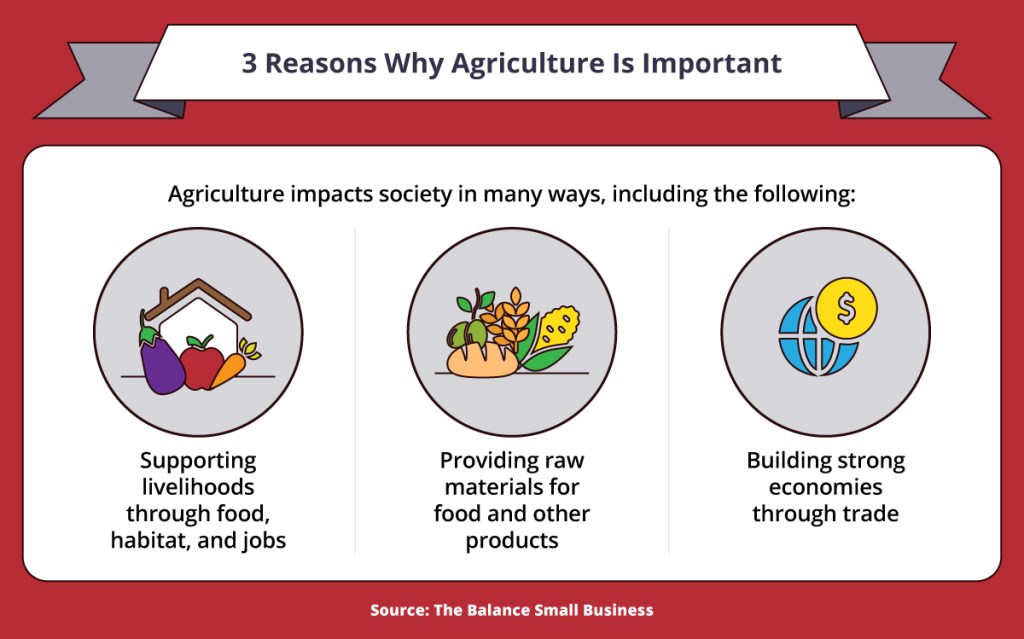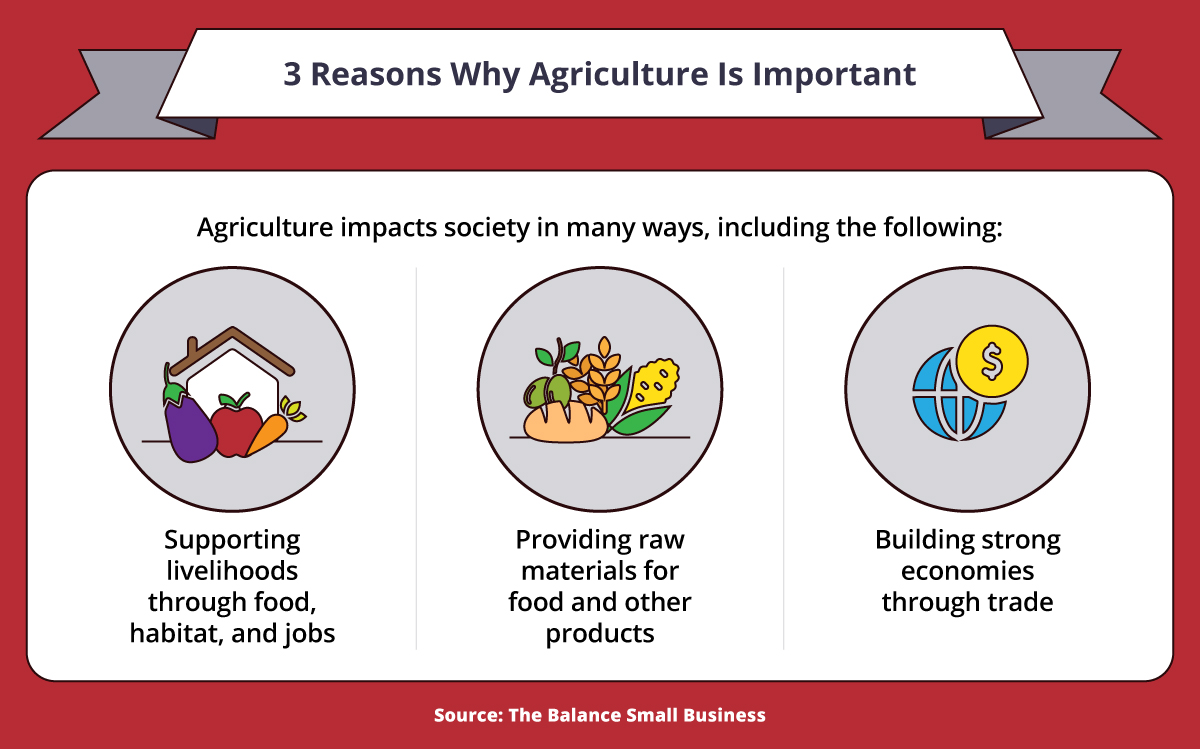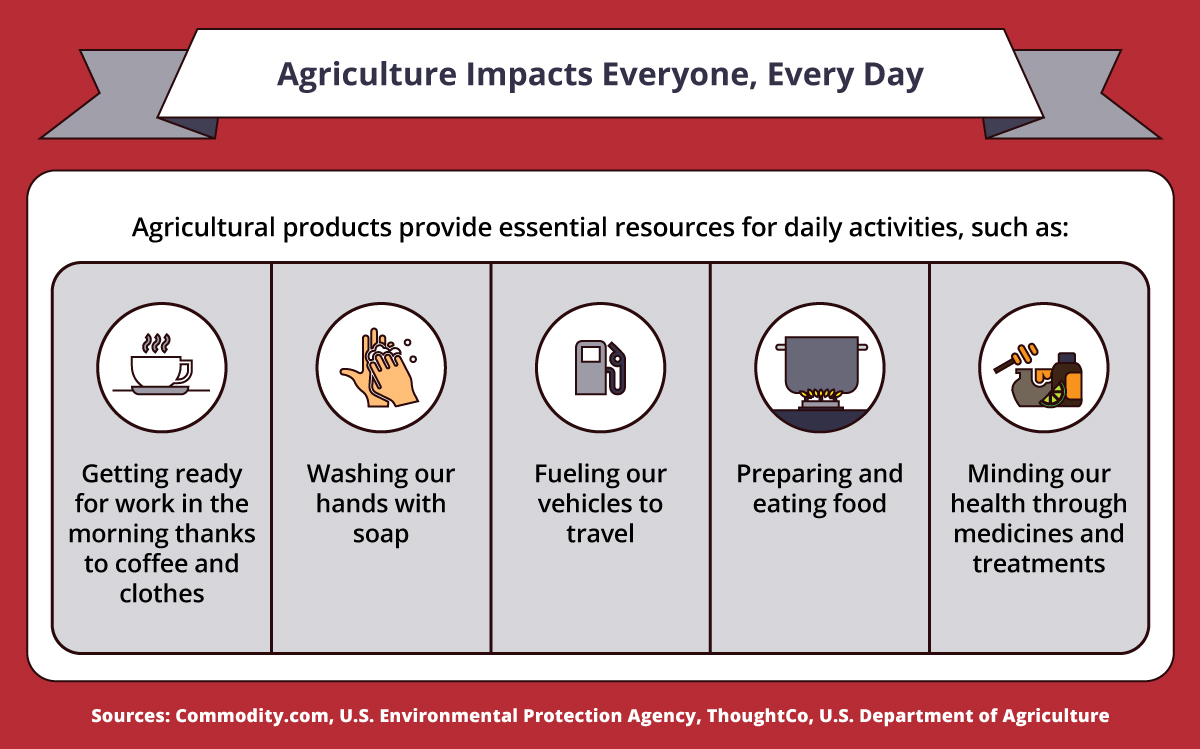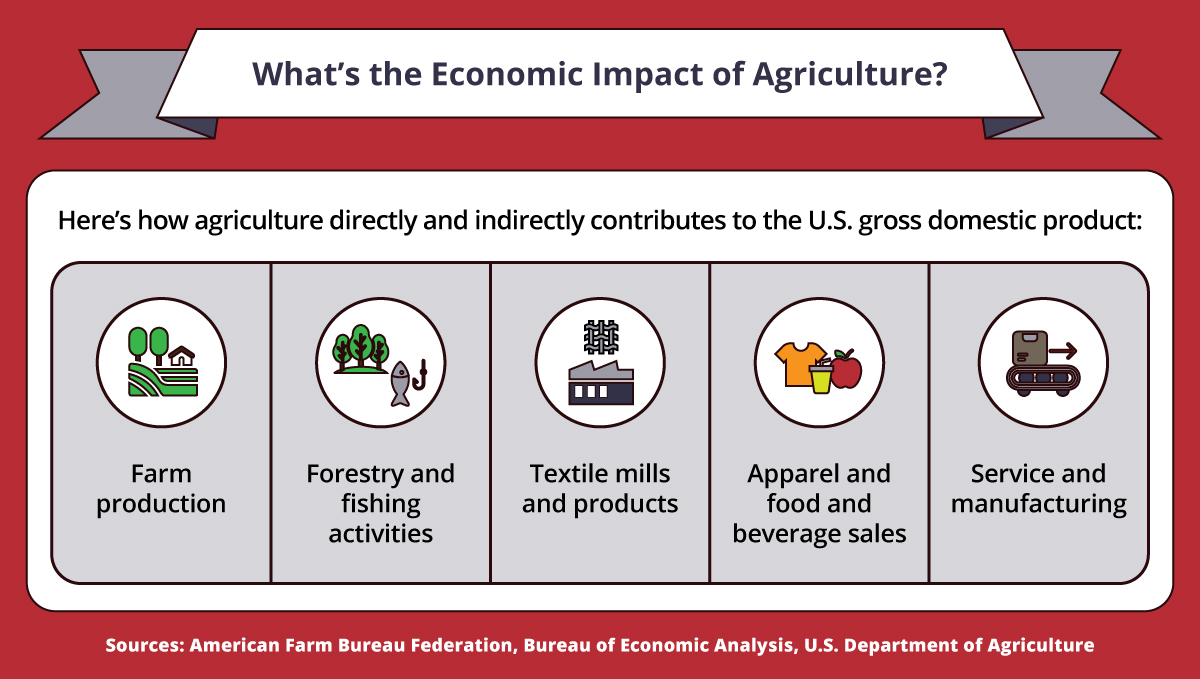Why Is Agriculture Important? Benefits and Its Role

Tables of Contents
When people think of agriculture, they often envision crop farming: soil and land preparation and sowing, fertilizing, irrigating, and harvesting different types of plants and vegetation.
However, according to the U.S. Census Bureau’s North American Industry Classification System (NAICS), crop farming is just one element of the Agriculture, Forestry, Fishing, and Hunting sector. Agriculture also encompasses raising livestock; industrial forestry and fishing; and agricultural support services, such as agricultural equipment repair and trucking operations.
Why is agriculture important? It helps sustain life by providing the food we need to survive. It also contributes $7 trillion to the U.S. economy. Despite agriculture’s importance, the Economic Policy Institute reports that farmworkers are among the lowest-paid workers in the U.S.
However, agriculture also provides opportunities for economic equity and helps people prosper around the world. For example, since 2000, the agricultural growth rate in Sub-Saharan Africa has surpassed that of any other region in the world (approximately 4.3% annually), contributing to the region’s economic gains, according to the United States Agency for International Development (USAID). While there’s been a global decline in agricultural jobs — from 1 billion in 2000 to 883 million in 2019, according to employment indicators from the Food and Agriculture Organization of the United Nations — agriculture remains the second-highest source of employment (26.7% of total work).
Study the impact of access to natural resources, such as water, air, plants and animals
The online BS in sustainability from Maryville University will prepare you to build a better, more sustainable future. Accelerate your degree completion with our transfer credit-friendly program. No SAT or ACT scores required.
- Engage in a range of relevant course topics, from biology to business statistics.
- Learn how human health is connected to the environment through environmental science and health courses.
What Is Agriculture?
Agriculture is the practice of cultivating natural resources to sustain human life and provide economic gain. It combines the creativity, imagination, and skill involved in planting crops and raising animals with modern production methods and new technologies.
Agriculture is also a business that provides the global economy with commodities: basic goods used in commerce, such as grain, livestock, dairy, fiber, and raw materials for fuel. For example, fiber is a top crop in U.S. agricultural production, according to The Balance Small Business, and a necessary commodity for the clothing sector.

Agriculture impacts society in many ways, including: supporting livelihoods through food, habitat, and jobs; providing raw materials for food and other products; and building strong economies through trade. Source: The Balance Small Business.
Why Is Agriculture Important?
A key to why agriculture is important to business and society is its output — from producing raw materials to contributing to the global supply chain and economic development.
Providing Raw Materials
Raw materials are a core building block of the global economy. Without access to raw materials, manufacturers can’t make products. Nonagricultural raw materials include steel, minerals, and coal. However, many raw materials derive from agriculture — from lumber for construction materials to herbs for adding flavor to food. Corn, for example, is used to produce foods and serves as a foundation for ethanol, a type of fuel. Another example is resins: plant products used in various industrial applications, such as adhesives, coatings, and paints used in construction.
Creating a Strong Supply Chain
Importing and exporting goods such as agricultural products requires shipping methods such as ocean freight, rail, and trucking. Delays in shipping agricultural products from a Los Angeles port can create problems in China, and vice versa, impacting the global supply chain.
For example, sales of soybean crops from Iowa skyrocketed in 2021 due to various factors including delays in South American crop shipments, according to the Iowa Soybean Association. In this example, Iowa benefited from a competitive standpoint. However, delays in shipping crops could also be detrimental to regions expecting shipment, limiting availability of products on store shelves and affecting livelihoods.
Encouraging Economic Development
Agriculture impacts global trade because it’s tied to other sectors of the economy, supporting job creation and encouraging economic development. Countries with strong agricultural sectors experience employment growth in other sectors, according to USAID. Countries with agricultural productivity growth and robust agriculture infrastructure also have higher per capita incomes, since producers in these countries innovate through technology and farm management practices to boost agricultural productivity and profitability.
Resources on the Importance of Agriculture
The following resources provide information about the importance of agriculture as a source of raw materials and its impact on transportation and contribution to economic development:
- American Farm Bureau Federation, Fast Facts About Agriculture & Food: Provides various statistics demonstrating why agriculture is important.
- The Western Producer, “Suddenly Agriculture Is Important”: Highlights agriculture’s role as a stable commodity provider even amid disruption.
- LinkedIn, “What Is Agriculture and Its Importance?”: Discusses the importance of agriculture in 10 areas.
How Is Agriculture Important?
When global supply chains are disrupted, considerable attention is given to the technology sector. For example, the lack of computer chips — made from silicon, a nonagricultural raw material — limits a manufacturer’s ability to make computers, cars, and other products. This impacts many areas of society and business.
Agriculture also plays a central role in meeting consumer and business market demand in a world with interconnected economies. Here are different types of products derived from agriculture.
Fruits and Vegetables
Fruits and vegetables are essential sources of fiber, proteins, and carbohydrates in human diets. Vitamins, such as A, C, and E, and minerals, such as magnesium, zinc, and phosphorus, are naturally occurring in many fruits and vegetables. In addition to health benefits, fruits and vegetables add flavors to the human palette.
Animal Feed
Some fruits and vegetables are grown to provide feed for animals, from poultry to livestock. The American Industry Feed Association reports that about 900 animal feed ingredients are approved by law in the U.S. These include ingredients that come from agricultural production, including hay, straw, oils, sprouted grains, and legumes.
Natural Rubber Production
The number of vehicles in the world is more than 1.4 billion, according to Hedges & Company market research. Every single one runs on rubber tires. According to GEP, the top rubber-producing countries are Thailand, Indonesia, and Malaysia — collectively representing approximately 70% of global natural rubber production — and about 90% of suppliers are small-scale farmers.
Cotton for Clothing
From cotton to clothes, the journey starts with agricultural production. Cotton is grown, harvested, and then processed, spun, and woven into fabric before it becomes a piece of clothing. Cotton production encompasses an expansive global supply chain, and according to Forum for the Future, it’s a leading commodity, making up approximately 31% of all textile fibers globally.
Biofuels
The U.S. Environmental Protection Agency (EPA) reports favorable economics of biofuels, produced from biomass sources including agricultural products such as corn, soybeans, sugarcane, and algae. The benefits include reduced greenhouse gas and pollutant emissions and the potential for increased incomes for farmers. However, biodiesel production requires the use of land and water resources that can affect food costs.
Industrial Products
Bio-based chemistry involves using raw materials derived from biomass to develop industrial products. Different industrial products derived from bio-based chemicals include bioplastics, plant oils, biolubricants, inks, dyes, detergents, and fertilizers. Bio-based chemicals and products offer an alternative to conventional products derived from petroleum products. Bio-based chemistry is considered a type of green chemistry because it promotes the reduction of environmental impacts in industrial production.
Pharmaceutical Products
For thousands of years, humans have turned to plants to help treat what ails them. For example, ginger, a plant root typically consumed in tea, can help aid digestion. Substances derived from plants and herbs can also help in healthcare. For example, extracted chemicals from the foxglove plant are used for digoxin, a drug used for heart failure. Another example is polylactic acid (PLA), a chemical produced when glucose is fermented into lactic acid in green plants. PLA has applications in tissue engineering, cardiovascular implants, orthopedic interventions, cancer therapy, and fabrication of surgical implants, according to a study published in Engineered Regeneration.

Agricultural products provide essential resources for daily activities, such as: getting ready for work in the morning, thanks to coffee and clothes; washing hands with soap; fueling vehicles to travel; preparing and eating food; and minding health through medicines and treatments. Sources: Commodity.com, the U.S. Environmental Protection Agency, ThoughtCo, and the U.S. Department of Agriculture.
Importance of Agriculture in Everyday Life
For thousands of years, agriculture has played an important role in everyday life. Before agriculture, hunting and gathering enabled humans to survive. It wasn’t until the transition to the planned sowing and harvesting of crops that humans began to thrive. Humans developed tools and practices to improve agricultural output with more efficient means of sustaining themselves. From there, innovations that created industries led to the modern era.
Today, the importance of agriculture in everyday life can’t be minimized. Without the agriculture sector, activities such as getting dressed for work and cleaning the home wouldn’t be possible. Here are examples of the agricultural products we use in our everyday lives:
- Shelter. Wood and plant-based materials, such as bamboo, can be used for indoor décor and construction materials.
- Morning routine. Mint is often an ingredient in toothpaste, adding flavor while brushing your teeth, and the caffeine in coffee that keeps you awake is derived from the coffee bean.
- Dressing up. In addition to cotton, clothing can be manufactured from hemp, ramie, and flax. Bio-based materials can be used to produce grooming products such as skin creams and shampoos.
- Cleaning. Two types of chemicals used in detergents, cleaning products, and bath or hand soap — surfactants and solvents — can be produced from biomass.
- Driving to work. Plants make it possible to get to and from work. Think of rubber (sourced from rubber trees) and biodiesel fuel, which often includes ethanol (sourced from corn).
- Entertainment. Paper from trees enables you to write, and some musical instruments, such as reed instruments, require materials made from plants.
- Education. From pencils (still often made of wood) to paper textbooks, students rely on agricultural products every day.
How Does Agriculture Affect the Economy?
Agriculture can have a significant effect on the economy. The U.S. Department of Agriculture (USDA) Economic Research Service reports that agricultural and food sectors provided 10% of all U.S. employment in 2020 — nearly 20 million full- and part-time jobs. Additionally, the USDA reported that cash receipts from crops totaled nearly $198 billion in 2020. Animal and animal product receipts weren’t far behind in 2020, totaling $165 billion.
The interdependence of the food and agriculture sector with other sectors, including water and wastewater systems, transportation systems, energy, and chemical, makes it a critical engine for economic activity, according to the Cybersecurity and Infrastructure Security Agency (CISA).
Agriculture also impacts economic development by contributing to the overall U.S. gross domestic product (GDP), directly and indirectly. It does so through farm production, forestry, fishing activities, textile mills and products, apparel and food and beverage sales, and service and manufacturing.
- Farm production. The latest USDA data on farming and farming income report the U.S. had a little over 2 million farms, encompassing 897 million acres, in 2020. Farm production includes producing fruits, vegetables, plants, and varieties of crops to meet demand for agricultural products throughout the country and abroad.
- Forestry and fishing activities. Agricultural activities include forestry and harvesting fish in water farms or in their natural habitat. Agroforestryis focused on “establishing, managing, using, and conserving forests, trees and associated resources in a sustainable manner to meet desired goals, needs, and values,” according to the USDA. A form of fishing activity known as aquaculture involves the production of fish and other sea animals under controlled conditions to provide food.
- Textile mills and products. The S. cotton industry produces $21 billion in products and services annually, according to the USDA. The industry has created various employment roles, such as growers, ginners, and buyers working on farms and in textile mills, cotton gins, offices, and warehouses.
- Apparel and food and beverage sales. Since agriculture is a business, selling products made from agricultural production is essential. A key aspect of the sales component in agriculture is to help growers build capacity and understand the market dynamics to meet the needs of customers, many of whom care deeply about Food services and eating and drinking places accounted for 10.5 million jobs in 2020, the largest share among all categories within the agriculture and food sectors, according to the USDA.
- Manufacturing. Agricultural products contribute to the manufacturing of a huge variety of goods, including food and beverage products, textiles, cleaning and personal products, construction materials, fuels, and more. According to the USDA, food and beverage manufacturing companies employ about 1.7 million people in the U.S.

Here’s how agriculture directly and indirectly contributes to the U.S. gross domestic product: farm production, forestry and fishing activities, textile mills and products, apparel and food and beverage sales, and service and manufacturing. Sources: American Farm Bureau Federation, the Bureau of Economic Analysis, and the USDA.
Here are ways agriculture and related industries impact economic development:
Agribusiness
Agribusiness consists of the companies that perform the commercial activities involved in getting agricultural goods to market. It includes all types of businesses in the food sector, from small family farms to global agricultural conglomerates. In the U.S., farms contributed about $136 billion to GDP (about 0.6% of total GDP) in 2019, according to the USDA.
However, farms are just one component of agribusiness. Agribusiness also includes businesses involved in manufacturing agricultural equipment (such as tractors) and chemical-based products (like fertilizers) and companies involved in the production and refinement of biofuels. USDA data reports that in total, farms and related industries contributed more than $1.1 trillion to GDP, a little over 5% of the GDP, in 2019.
The economics of agribusiness also entails building production systems and supply chains that help maintain a country’s economic and social stability. Through the development of organizational and technological knowledge, agribusiness plays a vital role in protecting the environment and biodiversity near farms and using natural resources sustainably.
Food Security
Food security is central to the agricultural industry: Sustainable agriculture is a key to fulfilling the United Nations’s Sustainable Development Goals (SDGs), including SDG 2: Zero Hunger. In addition to food security, the agricultural sector raises the incomes among the poorest communities up to four times more effectively than other sectors, according to the World Bank.
Job Creation
Throughout the world, agriculture plays an important role in job creation. For example, agriculture accounts for 25% of exports in developing countries in Latin America, about 5% of their regional GDP, according to a report about the importance of agribusiness from BBVA, a corporate and investment bank. This activity is a source of economic activity and jobs in these countries. In the U.S., agriculture and related industries provide 19.7 million full- and part-time jobs, about 10.3% of all employment.
Resources on the Economic Impact of Agriculture
The following resources highlight agriculture’s impact on the economy, from how disruption affects the business and the benefits of the sector to people’s livelihoods:
- Economic Research Service, Farming and Farm Income: Provides an overview of trends in farming and economic development statistics.
- American Journal of Agricultural Economics, “The Importance of Agriculture in the Economy: Impacts from COVID-19”: Highlights why agriculture is important based on the impact of COVID-19’s disruptions to the sector.
- Canadian Journal of Agricultural Economics, “Agriculture, Transportation, and the COVID-19 Crisis”: Discusses how transportation services that COVID-19 has disrupted can impact agricultural supply chains.
Importance of Agricultural Biodiversity
Advanced farming equipment and the increased use of fertilizers and pesticides have resulted in higher crop yields. At the same time, they’ve impacted the environment, contributing to soil and water pollution and climate change. NASA projects a 24% decline in corn crop yields by 2030, thanks to climate change. However, ensuring a healthy biodiversity can help mitigate the impact. Here are some factors to consider:
- Sustainable agriculture. Through sustainable agricultural practices, farmers and ranchers help ensure the profitability of their land while improving soil fertility, helping promote sound environmental practices, and minimizing environmental impacts through climate action.
- Climate change regulation. The agricultural sector produced about 10% of U.S. greenhouse gas emissions in 2019, according to the EPA. Regulation and policy changes can help promote sustainable practices in the sector and provide guidance on agricultural adaptation to address the challenges that climate change poses.
- Agriculture technology and innovation. From temperature- and moisture-sensing devices to GPS technologies for land surveys to robots, agriculture technology can result in higher crop yields, less chemical runoff, and lower impact on natural resources.
Agricultural Biodiversity Resources
Find information about agricultural biodiversity and its impacts in the following resources:
- Our World in Data, “Environmental Impacts of Food Production”: Discusses how sustainable agriculture offers a path to addressing food and nutrition issues.
- IBM, “The Benefits of Sustainable Agriculture and How We Get There”: Addresses how artificial intelligence (AI) and analytics technologies help farmers maximize food production and minimize their environmental impact.
- S. Environmental Protection Agency, The Sources and Solutions: Agriculture: Explains how agriculture can contribute to reducing nutrient pollution.
- FoodPrint, Biodiversity and Agriculture: Provides answers to what it will take to preserve the health of the planet to safeguard our own food supply.
- Brookings, “What Is the Future of Work in Agri-Food?”: Discusses the future of agricultural automation and its impact on work.
Why Is Agriculture Important for the Future?
Agriculture offers an opportunity to improve the lives of millions of food-insecure people and help countries develop economies that create jobs and raise incomes. Today’s agriculture also impacts future generations. To ensure the long-term success of the global agricultural sector, building a more sustainable economic system aligned with the U.N.’s Sustainable Development Goals is a crucial imperative to help create a more equitable society.
Infographic Sources
American Farm Bureau Federation, “Farm Contribution to Agricultural GDP at Record Low”
Commodity.com, “Learn All About Agricultural Commodities and Market Trends”
Environmental Protection Agency, Commonly Consumed Food Commodities
The Balance Small Business, “What Is Agricultural Production?”
ThoughtCo, “List of Medicines Made From Plants”
USDA, Ag and Food Sectors and the Economy
USDA National Agricultural Library, Industrial, Energy, and Non-food Crops

